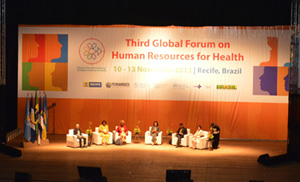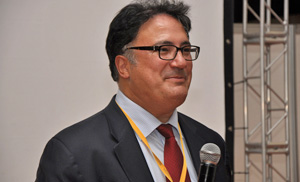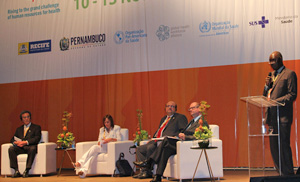
Sharing Outcomes from the Third Global Forum on Human Resources for Health
“The health worker is the most important element of the health system,” says Pape Gaye, president and CEO of CapacityPlus lead partner IntraHealth International. The Third Global Forum on Human Resources for Health (HRH) provided a vital opportunity to learn what’s working in terms of strengthening the health workforce worldwide, hear how far we still have to go, and gain clarity on what we need to do to get there. Held in Recife, Brazil, from November 10-13, the forum represented the largest-ever global gathering on HRH. IntraHealth was an official cohost and, with CapacityPlus, served as the organizer of Theme 4, “Empowerment and incentives: Harnessing health workers’ voice, rights, and responsibilities in moving toward universal health coverage.”
Held in Recife, Brazil, from November 10-13, the forum represented the largest-ever global gathering on HRH. IntraHealth was an official cohost and, with CapacityPlus, served as the organizer of Theme 4, “Empowerment and incentives: Harnessing health workers’ voice, rights, and responsibilities in moving toward universal health coverage.”
More than 1,800 health workforce champions took part, including 89 country delegations and 40 ministers. The US government sent a delegation of 28 members led by Dr. Ariel Pablos-Méndez, assistant administrator for global health at USAID.
Achieving HRH commitments: Lessons learned and resources from CapacityPlus
During a side session hosted by CapacityPlus, project leaders shared innovative resources and lessons learned from their application at the country level in the areas of health workforce planning, production, management, performance, and retention. Selected highlights from the presentation include:
- Sixteen countries are saving $120 million per year by using our open source human resources information system software, iHRIS, to support more than 675,000 health worker records.
- Through our HRH Global Resource Center, each month 60,000 people from 172 countries access the world’s largest collection of HRH resources and tools.
- In Nigeria, CapacityPlus is increasing the number of trained midwives and community health workers through a unique scholarship program for students at risk of dropping out due to financial reasons.
- The Dominican Republic is saving $4 million annually thanks to cleaning the health worker payroll to rid the system of ghost workers (those who remain on the payroll but are not actually working); the savings are being used to hire new health workers.
- In Uganda, the work of CapacityPlus and the Uganda Capacity Program helped the Ministry of Health to successfully advocate for $20 million in increased funding, which is being used to hire 8,000 new health workers and to double doctors’ salaries.
 At a reception hosted by IntraHealth, USAID’s Dr. Pablos-Méndez lauded CapacityPlus’s success in several key areas. “CapacityPlus has advanced our knowledge of the health workforce through improved technology for tracking them by region and country, which has allowed for informed decision-making and policy development or change regarding the health workforce,” he noted. And he cited the project’s Rapid Retention Survey Toolkit, which “allows governments to identify appropriate incentive packages to improve rural retention and increase worker motivation. Those packages can be costed using iHRIS Retain […]. In Laos, application of the toolkit and iHRIS Retain identified and costed appropriate incentive packages in support of the Ministry of Health’s new national recruitment and retention policy that requires compulsory rural service for all new graduates. To date, the policy has resulted in the placement of an additional 400 doctors, pharmacists, and dentists in one-third of the country’s districts.”
At a reception hosted by IntraHealth, USAID’s Dr. Pablos-Méndez lauded CapacityPlus’s success in several key areas. “CapacityPlus has advanced our knowledge of the health workforce through improved technology for tracking them by region and country, which has allowed for informed decision-making and policy development or change regarding the health workforce,” he noted. And he cited the project’s Rapid Retention Survey Toolkit, which “allows governments to identify appropriate incentive packages to improve rural retention and increase worker motivation. Those packages can be costed using iHRIS Retain […]. In Laos, application of the toolkit and iHRIS Retain identified and costed appropriate incentive packages in support of the Ministry of Health’s new national recruitment and retention policy that requires compulsory rural service for all new graduates. To date, the policy has resulted in the placement of an additional 400 doctors, pharmacists, and dentists in one-third of the country’s districts.”
Commitments to strengthen the health workforce
To date, 57 countries and 26 other groups have made HRH commitments, 70 of which were presented at the forum. These commitments share a common framework and outline the actions each government or group will take to help close the health worker gap and expand access to high-quality health care. CapacityPlus lead partner IntraHealth made its own commitment.
Key reports and documents launched during the forum
The Recife Political Declaration on Human Resources for Health
The Recife Political Declaration, agreed to by member states of the World Health Organization (WHO), presents a series of renewed commitments for countries to move with greater speed toward the goal of universal health coverage. The declaration includes the WHO’s commitment to work with member states, partners, and civil society to track progress and provide support. “Country after country has outlined actions that will ultimately transform and improve the landscape for health workers, and prioritize their needs in a world with ever growing demands being placed on them,” said Dr. Marie-Paule Kieny, WHO assistant director-general for health systems and innovation.
A Universal Truth: No Health without a Workforce
The Global Health Workforce Alliance and the WHO launched their new report, which consolidates data on health workforce availability, accessibility, acceptability, and quality from 36 countries and addresses ways to accelerate progress toward universal health coverage.
The global shortage of doctors, nurses, and midwives is now estimated at 7.2 million, and this figure is predicted to rise to 12.9 million by 2035 if the global community doesn’t take appropriate action. The report’s main recommendations, briefly, are to increase leadership at the country level to support long-term HRH efforts; collect reliable data; maximize the role of midlevel and community health workers; retain health workers where they’re needed most; and provide mechanisms for the voices of health workers to be heard.
Bulletin of the World Health Organization
A special edition on the theme of HRH for universal health coverage features success stories in tackling health workforce challenges, presents innovative approaches and new evidence, and explores the challenges of supplying enough human resources to achieve universal health coverage. It includes the following articles coauthored by CapacityPlus leaders:
- Community Health Workers for Universal Health Care Coverage: From Fragmentation to Synergy emphasizes the need for stronger public-sector leadership and more synergy among partners in better supporting and integrating community health workers as integral members of health teams that can increase accessibility and use of services.
- Early Implementation of WHO Recommendations for the Retention of Health Workers in Remote and Rural Areas discusses the lessons learned from adaptation and adoption of the WHO recommendations in Lao People’s Democratic Republic and South Africa, and explores the influence of the recommendations regionally in Asia and Europe.
- Leveraging Information Technology to Bridge the Health Workforce Gap offers 10 recommendations for training, empowering, and supporting health workers in resource-limited settings through the use of information and communication technologies.
Mid-level Health Workers for Delivery of Essential Health Services: A Global Systemic Review and Country Experiences
This report by the Global Health Workforce Alliance assesses the effectiveness of care by midlevel health workers from cadres requiring two to five years of training in basic skills in diagnosing, managing common conditions, and preventing disease.
WHO Education Guidelines 2013: Transforming and Scaling Up Health Professionals’ Education and Training
These guidelines consider new approaches in health professional education and are expected to increase regional- and country-based policies and technical dialogues with key stakeholders on how best to finance health training and prepare health professionals.
Redesigning the Health Care Workforce
This series of articles in the journal Health Affairs presents a range of perspectives on HRH strengthening.
Global Health Workforce Alliance awards
During a special ceremony, the Global Health Workforce Alliance presented four awards in the categories of 1) health worker working in remote/hardship area; 2) country-level decision-maker; 3) partner organization; and 4) journalist. IntraHealth served on the awards committee.
The health worker award recipient, Dr. Haruna Lule, is the principal medical officer at Gombe Hospital in Uganda. He was recognized for pioneering a hand hygiene project with the aim of strengthening infection control. Thanks to Dr. Lule’s efforts, postsurgery sepsis in the maternity ward decreased by over 60%, patients’ length of stay decreased from 4.6 to 3.5 days in most wards, and cross-infection of diarrhea cases among children in the pediatrics ward was drastically reduced. He accepted the Global Health Workforce Alliance’s invitation to join its board of directors.
The role of civil society During the forum, IntraHealth collaborated with a number of civil society organizations to develop an open letter that complements the Recife Political Declaration on HRH. The letter, which was read during the closing ceremony, states that we must keep health workforce issues at the center of our global development efforts. And a Health Workers Count civil society pledge, developed by IntraHealth and other members of the Health Workforce Advocacy Initiative, the Frontline Health Workers Coalition, and other civil society organizations, has been signed by over 50 organizations already.
During the forum, IntraHealth collaborated with a number of civil society organizations to develop an open letter that complements the Recife Political Declaration on HRH. The letter, which was read during the closing ceremony, states that we must keep health workforce issues at the center of our global development efforts. And a Health Workers Count civil society pledge, developed by IntraHealth and other members of the Health Workforce Advocacy Initiative, the Frontline Health Workers Coalition, and other civil society organizations, has been signed by over 50 organizations already.
“The message at the forum was loud and clear,” said Rüdiger Krech of the WHO. “Human resources for health are central in translating the vision of universal health coverage into reality.”
“Universal health coverage is within our reach,” wrote IntraHealth’s Pape Gaye in a recent blog post. “We’re envisioning a world in which every person has someone to turn to for basic health concerns and illness. And that someone is a health worker.”
Help CapacityPlus spread the word about strengthening the health workforce. Follow us on Twitter and like us on Facebook.
Related items:
Photo 1 by Alfredo Fort (High-level roundtable at Third Global Forum on HRH). Photo 2 by David Nelson (Dr. Ariel Pablos-Méndez). Photo 3 by Vince Blaser, courtesy of Frontline Health Workers Coalition (Pape Gaye at the closing ceremony).


